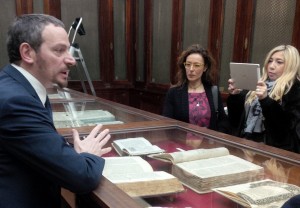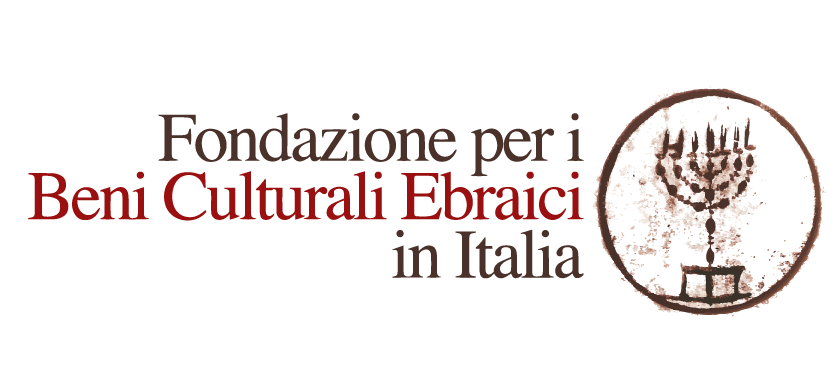From Moked
“The history of the Jewish Community in Naples goes back a long time, starting well before 1864″. This is how Giancarlo Lacerenza, Director of the Jewish Studies Centre at Naples University L’Orientale, presents the content of the volume “La Comunità ebraica di Napoli [1864-2014]: centocinquant’anni di storia” (“The Jewish Community of Naples (1864-2014): one hundred and fifty years of history”), a catalogue including a collection of essays recounting the city’s Jewish legacy, produced following the two exhibitions hosted by the National Library and by the State Records Office last year.
An initiative made possible due to the contribution of the Union of Italian Jewish Communities, the Foundation for Jewish Cultural Heritage in Italy, the Jewish Community of Naples together with the city’s States Records Office and the Ministry for Cultural Affairs and Tourism. The presentation was held in the Rari room at the Naples National Library, that also housed the exhibition and a dialogue being conducted with the journalist Titti Marrone, was addressed by the Councellor of the Union, Sandro Temin, the president of the Foundation, Dario Disegni, and the president of the Jewish Community of Naples, Lydia Schapirer. With them, the director of the Library, Mariolina Rascaglia, the director of the Central Institute for the General Catalogue of Italian Libraries and for Bibliographical Information, Simonetta Buttò, the director of the Naples State Records Office, Imma Ascione, and the rector of the Orientale, Elda Morlicchio. A small exhibition of a number of valuable antique Jewish volumes – handwritten and printed – preserved at the Library was also set up in an adjacent room.
“The age-old presence of the Jewish Community of Naples is particularly significant for the heritage of Italian Jewish cultural patrimony”, stated Mr. Disegni, recalling the Foundation’s lively interest in the exhibition for which the volume presented constitutes the catalogue, also demonstrated by a visit from the Board, which last February decided to hold its meeting in the city. “Memory is the cornerstone of Jewish culture and today we can rejoice in our past”, added Sandro Temin, conveying the good wishes of the Union’s president, Renzo Gattegna. “Alongside this awareness, however”, he continued, “we are a living community, that wants to move ahead”.
The exhibitions hosted by the National Library and the State Records Office combined family photographs with the precious furnishings of the synagogue and interweaved the evidence given in public and private documents, testifying to the deep roo ts of Neapolitan Jews in local society. A research process that “placed all those who took part in its implementation in the right position to express potentialities and ideas”, explains Ms Buttò, stressing that the catalogue constitutes “ the exhibition’s life insurance”. An important experience also for Ms Rascaglia, who said that “by working together we have seen what the dialogue between cultures effectively means”. This cooperation, observed Ms Morlicchio, actually started even before the implementation of the exhibitions and goes back to at least 2008, the year in which the Jewish Studies Centre at the Orientale was founded. “I hope that the cohesion and the synergies may continue in the future”, is the wish expressed by Ms Schapirer, “because we need these in order to move ahead”.
ts of Neapolitan Jews in local society. A research process that “placed all those who took part in its implementation in the right position to express potentialities and ideas”, explains Ms Buttò, stressing that the catalogue constitutes “ the exhibition’s life insurance”. An important experience also for Ms Rascaglia, who said that “by working together we have seen what the dialogue between cultures effectively means”. This cooperation, observed Ms Morlicchio, actually started even before the implementation of the exhibitions and goes back to at least 2008, the year in which the Jewish Studies Centre at the Orientale was founded. “I hope that the cohesion and the synergies may continue in the future”, is the wish expressed by Ms Schapirer, “because we need these in order to move ahead”.
Alongside historic vicissitudes, “in the catalogue there converge many recent accounts that fortunately the Jewish Community has started to collect”, underlined Ms Marrone. A job that should be continued on a priority basis, also according to Mr. Lacerenza: “This is a research itinerary that should be urgently undertaken”, these are his words, “to activate the retrieval of a memory that, if we do not cultivate it, will be lost”. The professor then took the large audience present in the room through the entire history of Judaism in Naples, rooted in the territory since ancient times, one of its more important legacies being represented by the valuable manuscripts and printed texts produced in the course of time. Some examples, preserved in the National Library, are now on show near the Rari room; two examples will soon go to Venice to be exhibited for the five hundredth anniversary of the Ghetto. “Most people know that there was a real multitude of booksellers in Naples during the 15th century”, concluded Giancarlo Lacerenza, explaining the particulars of the volumes, “bearing witness to an ever active cultural life”.
Francesca Matalon twitter @fmatalonmoked
(3 marzo 2016)




